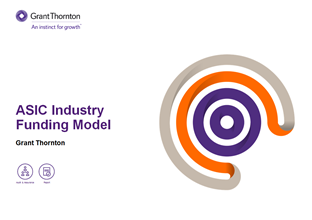- Market services
-
Compliance audits & reviews
Our audit team undertakes the complete range of audits required of Australian accounting laws to help you to help you meet obligations or fulfil best practice procedures.
-
Audit quality
We are fiercely dedicated to quality, use proven and globally tested audit methodologies, and invest in technology and innovation.
-
Financial reporting advisory
Our financial reporting advisory team helps you understand changes in accounting standards, develop strategies and communicate with your stakeholders.
-
Audit advisory
Grant Thornton’s audit advisory team works alongside our clients, providing a full range of reviews and audits required of your business.
-
Digital assurance
We capture actionable, quality insights from data within your financial reporting and auditing processes.

-
Corporate tax & advisory
We provide comprehensive corporate tax and advisory service across the full spectrum of the corporate tax process.
-
Private business tax & advisory
We work with private businesses and their leaders on all their business tax and advisory needs.
-
Tax compliance
We work alongside clients to manage all tax compliance needs and identify potential compliance or tax risk issues.
-
Employment tax
We help clients understand and address their employment tax obligations to ensure compliance and optimal tax positioning for their business and employees.
-
International tax
We understand what it means to manage tax issues across multiple jurisdictions, and create effective strategies to address complex challenges.
-
GST, stamp duty & indirect tax
Our deep technical knowledge and practical experience means we can help you manage and minimise the impact of GST and indirect tax, like stamp duty.
-
Tax law
Our team – which includes tax lawyers – helps you understand and implement regulatory requirements for your business.
-
Innovation Incentives
Our national team has extensive experience navigating all aspects of the government grants and research and development tax incentives.
-
Transfer pricing
Transfer pricing is one of the most challenging tax issues. We help clients with all their transfer pricing requirements.
-
Tax digital consulting
We analyse high-volume and unstructured data from multiple sources from our clients to give them actionable insights for complex business problems.
-
Corporate simplification
We provide corporate simplification and managed wind-down advice to help streamline and further improve your business.
-
Superannuation and SMSF
Increasingly, Australians are seeing the benefits, advantages and flexibility of taking control of their own superannuation and retirement planning.

-
Payroll consulting & Award compliance
Many organisations are grappling with a myriad of employee agreements and obligations, resulting in a wide variety of payments to their people.
-
Cyber resilience
The spectrum of cyber risks and threats is now so significant that simply addressing cybersecurity on its own isn’t enough.
-
Internal audit
We provide independent oversight and review of your organisation's control environments to manage key risks, inform good decision-making and improve performance.
-
Financial crime
Our team helps clients navigate and meet their obligations to mitigate crime as well as develop and implement their risk management strategies.
-
Consumer Data Right
Consumer Data Right (CDR) aims to provide Australians with more control over how their data is used and disclosed.
-
Risk management
We enable our clients to achieve their strategic objectives, fulfil their purpose and live their values supported by effective and appropriate risk management.
-
Controls assurance
In Australia, as with other developed economies, regulatory and market expectations regarding corporate transparency continue to increase.
-
Governance
Through fit for purpose governance we enable our clients to make the appropriate decisions on a timely basis.
-
Regulatory compliance
We enable our clients to navigate and meet their regulatory and compliance obligations.

-
Forensic accounting and dispute advisory
Our team advises at all stages of a litigation dispute, taking an independent view while gathering and reviewing evidence and contributing to expert reports.
-
Investigations
Our licensed forensic investigators with domestic and international experience deliver high quality results in the jurisdictions in which you operate.
-
Asset tracing investigations
Our team of specialist forensic accountants and investigators have extensive experience in tracing assets and the flow of funds.

-
Mergers and acquisitions
Our mergers and acquisitions specialists guide you through the whole process to get the deal done and lay the groundwork for long-term success.
-
Acquisition search & strategy
We help clients identify, finance, perform due diligence and execute acquisitions to maximise the growth opportunities of your business.
-
Selling a business
Our M&A team works with clients to achieve a full or partial sale of their business, to ensure achievement of strategic ambitions and optimal outcomes for stakeholders.
-
Operational deal services
Our operational deal services team helps to ensure the greatest possible outcome and value is gained through post merger integration or post acquisition integration.
-
Transaction advisory
Our transaction advisory services support our clients to make informed investment decisions through robust financial due diligence.
-
ESG Due Diligence
Our ESG due diligence process evaluates a company's environmental, social, and governance factors during the pre-investment phase to determine the overall maturity of the entity, manage potential risks, and identify opportunities.
-
Business valuations
We use our expertise and unique and in-depth methodology to undertake business valuations to help clients meet strategic goals.
-
Tax in mergers & acquisition
We provide expert advice for all M&A taxation aspects to ensure you meet all obligations and are optimally positioned.

-
Corporate finance
We provide effective and strategic corporate finance services across all stages of investments and transactions so clients can better manage costs and maximise returns.
-
Debt advisory
We work closely with clients and lenders to provide holistic debt advisory services so you can raise or manage existing debt to meet your strategic goals.
-
Working capital optimisation
Our proven methodology identifies opportunities to improve your processes and optimise working capital, and we work with to implement changes and monitor their effectiveness.
-
Capital markets
Our team has significant experience in capital markets and helps across every phase of the IPO process.
-
Debt and project finance raising
Backed by our experience accessing full range of available funding types, we work with clients to develop and implement capital raising strategies.
-
Private equity
We provide advice in accessing private equity capital.
-
Financial modelling
Our financial modelling advisory team provides strategic, economic, financial and valuation advice for project types and sizes.
-
Payments advisory
We provide merchants-focused payments advice on all aspects of payment processes and technologies.

-
Voluntary administration & DOCA
We help businesses considering or in voluntary administration to achieve best possible outcomes.
-
Corporate insolvency & liquidation
We help clients facing corporate insolvency to undertake the liquidation process to achieve a fair and orderly company wind up.
-
Complex and international insolvency
As corporate finance specialists, Grant Thornton can help you with raising equity, listings, corporate structuring and compliance.
-
Safe Harbour advisory
Our Safe Harbour Advisory helps directors address requirements for Safe Harbour protection and business turnaround.
-
Bankruptcy and personal insolvency
We help clients make informed choices around bankruptcy and personal insolvency to ensure the best personal and stakeholder outcome.
-
Creditor advisory services
Our credit advisory services team works provides clients with credit management assistance and credit advice to recapture otherwise lost value.
-
Small business restructuring process
We provide expert advice and guidance for businesses that may need to enter or are currently in small business restructuring process.
-
Asset tracing investigations
Our team of specialist forensic accountants and investigators have extensive experience in tracing assets and the flow of funds.

-
Independent business reviews
Does your company need a health check? Grant Thornton’s expert team can help you get to the heart of your issues to drive sustainable growth.
-
Commercial performance
We help clients improve commercial performance, profitability and address challenges after internal or external triggers require a major business model shift.
-
Safe Harbour advisory
Our Safe Harbour advisory helps directors address requirements for Safe Harbour protection and business turnaround.
-
Corporate simplification
We provide corporate simplification and managed wind-down advice to help streamline and further improve your business.
-
Director advisory services
We provide strategic director advisory services in times of business distress to help directors navigate issues and protect their company and themselves from liability.
-
Debt advisory
We work closely with clients and lenders to provide holistic debt advisory services so you can raise or manage existing debt to meet your strategic goals.

-
Business planning & strategy
Our clients can access business planning and strategy advice through our value add business strategy sessions.
-
Private business company secretarial services
We provide company secretarial services and expert advice for private businesses on all company secretarial matters.
-
Outsourced accounting services
We act as a third-party partner to international businesses looking to invest in Australia on your day-to-day finance and accounting needs.
-
Superannuation and SMSF
We provide SMSF advisory services across all aspects of superannuation and associated tax laws to help you protect and grow your wealth.
-
Management reporting
We help you build comprehensive management reporting so that you have key insights as your business grows and changes.
-
Financial reporting
We help with all financial reporting needs, including set up, scaling up, spotting issues and improving efficiency.
-
Forecasting & budgeting
We help you build and maintain a business forecasting and budgeting model for ongoing insights about your business.
-
ATO audit support
Our team of experts provide ATO audit support across the whole process to ensure ATO requirements are met.
-
Family business consulting
Our family business consulting team works with family businesses on running their businesses for continued future success.
-
Private business taxation and structuring
We help private business leaders efficiently structure their organisation for optimal operation and tax compliance.
-
Outsourced CFO services
Our outsourced CFO services provide a full suite of CFO, tax and finance services and advice to help clients manage risk, optimise operations and grow.
-
ESG, sustainability and climate reporting
There is a growing demand for organisations to provide transparency on their commitment to sustainability and disclosure of the nonfinancial impacts of their business activities. Commonly, the responsibility for sustainability and ESG reporting is landing with CFOs and finance teams, requiring a reassessment of a range of reporting processes and controls.
-
ESG, sustainability and climate advisory
With the ESG and sustainability landscape continuing to evolve, we are focussed on helping your business to understand what ESG and sustainability represents and the opportunities and challenges it can provide.
-
ESG, sustainability and climate reporting assurance
As the demand for organisations to prepare information in relation to ESG & sustainability continues to increase, through changes in regulatory requirements or stakeholder expectations, there is a growing need for assurance over the information prepared.
-
ESG and sustainability due diligence
As environmental, social, and governance (ESG) considerations become increasingly pivotal for dealmakers in Australia, it is important for investors to feel confident in assessing transactions through an ESG lens.

-
Management consulting
Our management consulting services team helps you to plan and implement the right strategy to deliver sustainable growth.
-
Financial consulting
We provide financial consulting services to keep your business running so you focus on your clients and reaching strategic goals.

-
China practice
The investment opportunities between Australia and China are well established yet, in recent years, have also diversified.
-
Japan practice
The trading partnership between Japan and Australia is long-standing and increasingly important to both countries’ economies.
-
India practice
It’s an exciting time for Indian and Australian businesses looking to each jurisdiction as part of their growth ambitions.
-
Singapore practice
Our Singapore Practice works alongside Singaporean companies to achieve growth through investment and market expansion into Australia.
-
Vietnam practice
Investment and business opportunities in Vietnam are expanding rapidly, driven by new markets, diverse industries, and Vietnam's growing role in export manufacturing, foreign investment, and strong domestic demand.

-
 Client Alert Wine not? Primary production land tax exemption no longer on the vineFor wine producers and vineyard owners, the recent New South Wales Civil and Administrative Tribunal decision in Zonadi Holdings Pty Ltd ATF Wombat Investment Trust v Chief Commissioner of State Revenue [2025] NSWCATAD 84 may spell trouble for their current primary production land tax exemptions.
Client Alert Wine not? Primary production land tax exemption no longer on the vineFor wine producers and vineyard owners, the recent New South Wales Civil and Administrative Tribunal decision in Zonadi Holdings Pty Ltd ATF Wombat Investment Trust v Chief Commissioner of State Revenue [2025] NSWCATAD 84 may spell trouble for their current primary production land tax exemptions. -
 Client Alert Unlock 2025: government grants updateIf government grants are part of your 2025 strategy, take note of the available quarter one funding opportunities. With increasing inflationary pressures, government grants can be an essential alternative funding source for businesses with critical investment projects.
Client Alert Unlock 2025: government grants updateIf government grants are part of your 2025 strategy, take note of the available quarter one funding opportunities. With increasing inflationary pressures, government grants can be an essential alternative funding source for businesses with critical investment projects. -
 Report Agribusiness, Food & Beverage Dealtracker 2024Merger & Acquisition (M&A) and equity market activity in the Agribusiness, Food & Beverage (Ag, F&B) sector is undergoing a strategic shift, as investors have become more selective and increasingly cautious in response to global economic uncertainty.
Report Agribusiness, Food & Beverage Dealtracker 2024Merger & Acquisition (M&A) and equity market activity in the Agribusiness, Food & Beverage (Ag, F&B) sector is undergoing a strategic shift, as investors have become more selective and increasingly cautious in response to global economic uncertainty. -
 Client Alert Government Grants in FY25As we embark on a new financial year, it’s crucial to take a strategic approach to understanding the government grants landscape.
Client Alert Government Grants in FY25As we embark on a new financial year, it’s crucial to take a strategic approach to understanding the government grants landscape.
-
Renewable Energy
Transformation through energy transition

-
Flexibility & benefits
The compelling client experience we’re passionate about creating at Grant Thornton can only be achieved through our people. We’ll encourage you to influence how, when and where you work, and take control of your time.
-
Your career development
At Grant Thornton, we strive to create a culture of continuous learning and growth. Throughout every stage of your career, you’ll to be encouraged and supported to seize opportunities and reach your full potential.
-
Diversity & inclusion
To be able to reach your remarkable, we understand that you need to feel connected and respected as your authentic self – so we listen and strive for deeper understanding of what belonging means.
-
In the community
We’re passionate about making a difference in our communities. Through our sustainability and community engagement initiatives, we aim to contribute to society by creating lasting benefits that empower others to thrive.
-
Graduate opportunities
As a new graduate, we aim to provide you more than just your ‘traditional’ graduate program; instead we kick start your career as an Associate and support you to turn theory into practice.
-
Vacation program
Our vacation experience program will give you the opportunity to begin your career well before you finish your degree.
-
The application process
Applying is simple! Find out more about each stage of the recruitment process here.
-
FAQs
Got questions about applying? Explore frequently asked questions about our early careers programs.
-
Our services lines
Learn about our services at Grant Thornton
-
Current opportunities
Current opportunities
-
Remarkable people
Our team members share their remarkable career journeys and experiences of working at Grant Thornton.
-
Working at Grant Thornton
Explore our culture, benefits and ways we support you in your career.
-
Current opportunities
Positions available.
-
Contact us
Get in touch
The Australian Government has introduced a new funding system for the Australian Securities and Investments Commission (ASIC), the ‘ASIC Industry Funding Model’, which will pass on greater compliance costs to Australian businesses.
In Brief
Effective 01 July 2017, this model will allow ASIC to recoup its costs directly from regulated businesses through a combination of approximately 50 different industry subsector levies. Forecast to raise $240 million in 2017-18, the levy will be based upon a company’s activities within the financial year, and is charged on an ex-post basis six months after the end of the year.
For many businesses the true nature of these costs will not be known until the beginning of 2019 when ASIC will release the first levy invoices.
Who will this affect?
Large proprietary companies, public companies both listed and unlisted, credit unions, financial advisers and other professional service sectors regulated by ASIC will face new costs depending on the activities they are licensed to do and their market share.
The levy explained
The Funding Model consists of an array of basic levies for some industry subsectors and variable market-share based levies for others.
In many cases where there is a minimum levy alongside a variable component, ASIC will invoice businesses based on their license conditions rather than their actual activity in a subsector.
ASIC will calculate the levy burden on a business based on:
- ASIC’s regulatory costs for the previous financial year, reported as soon as practicable after 31 October of the new financial year in its new Annual Dashboard.
- Regulated businesses’ share of the subsector market. Market share is based on individual entity data, submitted to ASIC after the conclusion of the financial year (in most cases, the submission date will be between 31 August and 31 October). ASIC has yet to advise on the form in which data should be submitted by affected businesses for the purposes of levy calculation.
First invoices in January 2019
ASIC will impose the levy on an ex-post basis. For the 2017-18 financial year, ASIC will send invoices in January 2019, payable within 30 days.
For late payment, the legislation allows ASIC to impose a penalty of 20% p.a. of the outstanding levied amount, calculated monthly, for amounts paid after the due date.
ASIC also has the power to deregister companies or suspend the licenses of practitioners if they fail to pay the levy more than 12 months from due date.
Australian Financial Services Licensees
Where a company’s AFSL allows them to act in a certain capacity, ASIC will invoice the licensee as if they are part of that subsector. In addition, these companies will face a basic levy on most forms submitted to ASIC.
As such, affected entities should note that they may fall within multiple subsectors subject to a levy, depending on applicable licenses held and activities conducted.
Companies
On top of existing charges for filing forms with ASIC, large proprietary companies, unlisted and listed companies will face new levies:
- Large proprietary companies will pay an estimated $350 extra per year
- Unlisted public companies will pay between $170-$3,350 extra per year, depending on whether they are disclosing or non-disclosing
- Listed companies face an extra levy of $4,000 as a minimum, followed by a variable levy for market capitalisation over $5 million at 30 June. This will significantly impact the compliance costs of any listed entity.
New data collection and compliance costs
ASIC now has the ability to mandate submission of revenue and other data for the purposes of determining market share. This will allow ASIC to calculate the size of an industry subsector and the appropriate quantum of levy to impose.
ASIC has indicated that it will use data sources unique to the levied business sector to calculate the payable levy. Some of these data sources are external to a company (e.g. market capitalisation, ASIC license registers). Other subsectors (e.g. auditors, credit unions, responsible entities, and wholesale trustees) must collect and submit information ASIC deems necessary to calculate market share and the associated levy burden.
The data ASIC requires from each industry subsector will be clearer when ASIC releases this information later in the 2017-18 financial year.
Estimates by subsector
Below is an outline of the calculation method and levy estimate for each industry subsector liable to pay a levy under the Industry Funding Model.
The levy calculation method for each subsector (basic; mixed basic and variable) is taken from the ASIC Supervisory Cost Recovery Levy Regulations 2017, registered on 29 June 2017. Minimum levies, as well as thresholds where appropriate, are also taken from the Regulations.
The estimated ‘basic levy’ and ‘amount to raise’ quoted for each industry subsector come from ASIC’s document Proposed Industry Funding Model for ASIC: Supporting attachment to the Government's Proposals Paper 1, released in November 2016. To date, this is the latest information the Australian Government has provided to assist stakeholders to calculate their levy burden.
The estimates do not include individual compliance costs for collating and submitting individual data ASIC will use to determine market activity and calculate individual entities’ levy obligations.
Where the subsectors in ASIC’s November 2016 paper are largely identical to those in the Regulations, we include an estimate of the levy charge on a representative company in that subsector, based on ASIC’s estimated amount to raise and number of leviable entities. However, where the subsector definitions differ significantly between November 2016 and June 2017, we have not included an estimate of the cost to a representative company.
Basic levies by subsector
Sector and subsector |
Estimated basic levy |
| Companies | |
| Large Proprietary Companies | $350 |
| Unlisted Public Companies (disclosing and non-disclosing) | $170 up to $3,350 2 |
| Deposit taking and credit | |
| Margin lenders (pro-rated) | $11,100 |
| Investment management, superannuation and related services | |
| Custodians | $560 |
| Managed discretionary account providers (pro-rated) | $3,000 |
| Traditional trustee company service providers (pro-rated) | $20,500 |
| Financial advice | |
| Licensees that provide only general advice to retail or wholesale clients | $920 |
| Licensees that provide personal advice to retail clients on only products that are not relevant financial products (Tier 2 products; pro-rated) | $1,500 |
| Licensees that provide personal advice to only wholesale clients (pro-rated) | $170 |
| Market infrastructure and intermediaries | |
| Australian derivative trade repository operators (per repository) | $140,000 |
| Credit rating agencies (pro-rated) | $34,000 |
| Exempt clearing and settlement facility operators (per facility) | $45,000 |
| Exempt market operators (per market) | $45,000 |
| Overseas market operators (per market) | $90,000 |
| Large futures exchange operators (per exchange) | $1.4 million |
| Retail over-the-counter derivatives issuers (pro-rated) | $61,400 |
| Small derivatives market operators (per market) | $50,000 |
| Small securities exchange operators (per exchange) | $200,000 |
| Small securities exchange operators with self-listing function only (per exchange) | $45,000 |
| Small futures exchange operators (per exchange) | $200,000 |
| Tier 1 clearing and settlement facility operators (per facility) | $436,000 |
| Tier 2 clearing and settlement facility operators (per facility) | $200,000 |
| Tier 3 clearing and settlement facility operators (per facility) | $80,000 |
| Tier 4 clearing and settlement facility operators (per facility) | $45,000 |
| Wholesale electricity dealers | $1,600 |
| Insurance | |
| Insurance product distributors (not applicable to providers) | $2,400 |
| Risk management product providers (pro-rated) | $4,500 |
Mixed/variable levies by subsector
Companies
| Subsector | Amount to raise | Affected entities | Levy metric | Minimum - maximum levy | Additional compliance costs anticipated for submitting levy calculation data to ASIC? | Representative entity's estimated levy |
| Listed Public Companies | $48.5 million | 2,000 | Based on market capitalisation at the end of the financial year. Minimum levy only if market capitalisation under $5 million. Companies with a market capitalisation between $5 million-$20 billion 3 will pay the minimum levy plus an estimated $0.33 graduated levy per $10,000 market capitalisation over the minimum threshold. |
$4,000 minimum. Estimated $662,000 maximum | No | Listed Company A, market capitalisation $3 million, will pay the minimum $4,000 levy. Listed Company B, market capitalisation $200 million, will pay $4,000 plus an estimated $6,435 in graduated levy (total $10,435). |
Corporate
| Subsector | Amount to raise | Affected entities | Levy metric | Minimum - maximum levy | Additional compliance costs anticipated for submitting levy calculation data to ASIC? | Representative entity's estimated levy |
| Auditors | $0.8 million from RCAs; $4.3 million from audit firms | 4,700 RCAs; 125 audit firms | Basic levy per Registered Company Auditor plus a variable component based on share of all auditors' consolidated listed company audit fees. | Estimated $170 per RCA | Yes | An audit firm with 50 Registered Company Auditors, earning 10% of all revenue for applicable audits in the Australian market, will pay an estimated total levy of $8,500 plus $430,000 (total $438,500). |
| Registered Liquidators | $8.5 million | 710 | Minimum levy plus a variable component based on each liquidator’s share of the total number of notifiable events for the subsector 4. | $2,500 per registered liquidator | No | A firm with 10 registered liquidators and has 5% of the ‘notifiable events’ relevant for the levy calculation will pay a minimum levy of $25,000 plus an estimated $336,250 (total $361,250). |
Deposit-taking and credit sector
| Subsector | Amount to raise | Affected entities | Levy metric | Minimum - maximum levy | Additional compliance costs anticipated for submitting levy calculation data to ASIC? | Representative entity's estimated levy |
| Credit intermediaries | $15.8 million | 5,100 | Minimum levy plus a variable component based on the share of credit representatives the intermediary has in a financial year. | $1,000 minimum | Yes | A credit intermediary with 10% of Australia’s credit representatives will pay a minimum $1,000 plus an estimated $1.07 million (total $1,071,000). |
| Credit providers | $9.3 million | 1,271 | Minimum levy plus variable component based on credit contracts (actual amounts rather than approvals) made totalling more than $100 million in a financial year (estimated $0.15 per $10,000). | $2,000 minimum | Yes | A credit provider with $1 billion in credit contracts will pay $2,000 plus an estimated $13,500 (total $15,500). |
| Small amount credit providers | $2.0 million | 332 | These are part of the credit providers subsector, paying the minimum levy mentioned above. They will also pay a variable component based on their share of the subsector’s total value of credit provided under small amount credit contracts in the financial year. | $2,000 minimum | Yes | A small amount credit provider issuing $40 million in small amount contracts in a financial year (around 10% of the small amount credit market) will pay $2,000 plus an estimated $200,000 in variable levy (total $202,000) |
| Deposit product providers | $3.1 million | 258 | Minimum levy plus variable component for deposit liabilities above $10 million (estimated $0.02 per $10,000). | $2,000 minimum | Yes | A deposit provider with deposit liabilities of $1 billion will pay $2,000 plus an estimated $1,980 in variable levy (total $3,980). |
| Payment product providers | $2.4 million | 266 | Estimated $9,000 basic levy in 2017-2018. Thereafter, minimum levy plus a variable component based on the provider's share of the subsector’s gross revenue related to issued non-cash payment products, less expenses from dealing in non-cash payment facilities. | $2,000 minimum | Yes | A payment product provider with 1% market share will pay $2,000 plus an estimated $18,680 for the 2018-2019 financial year (total $20,680). |
Investment management, superannuation and related services sector
| Subsector 5 | Amount to raise | Affected entities | Levy metric | Minimum - maximum levy | Additional compliance costs anticipated for submitting levy calculation data to ASIC? | Representative entity's estimated levy |
| Operators of investor directed portfolio services | $1.6 million | 35 | Minimum levy plus a variable component based on the operator’s share of the subsector's gross revenue from IDPS activities in the financial year 6. | $10,000 minimum | Yes | An IDPS operator with 10% market share will pay $10,000 plus an estimated $125,000 in variable levy (total $135,000). |
| Responsible entities | $23.5 million | 490 | A minimum levy plus a variable component based on the entity’s share of the total value of assets in all registered schemes above $10 million (estimated $0.24 per $10,000). | $7,000 minimum | Yes | A responsible entity with funds under management of $1 billion will pay $7,000 plus an estimated $23,760 in variable levy (total $30,760). |
| Superannuation trustees | $8.5 million | 144 | Minimum levy plus a variable component based on the trustee’s share of the total value of assets in all registrable super schemes greater than $250 million (estimated $0.05 per $10,000). | $18,000 minimum | Yes | A superannuation trustee with funds under management of $1 billion will pay $18,000 plus an estimated $3,750 in variable levy (total $21,750). |
| Wholesale trustees | $13.8 million | 1,749 | Estimated $8,000 basic levy for the 2017-18 financial year. Thereafter, trustees will pay a minimum levy plus a variable component based on their share of the total value of assets issued in unregistered managed investment schemes. | $1,000 minimum | Yes | A wholesale trustee with a market share of 1% will pay $1,000 plus an estimated $120,510 in variable levy (total $121,510). |
Financial advice sector
| Subsector | Amount to raise | Affected entities | Levy metric | Minimum - maximum levy | Additional compliance costs anticipated for submitting levy calculation data to ASIC? | Representative entity's estimated levy |
| Licensees that provide personal advice on relevant financial products to retail clients (Tier 1 products) | $22 million | 2,150 licensees with 23,000 advisers | Minimum levy plus a variable amount based on licensee's share of registered financial planners authorised to provide advice on the licensee’s behalf (estimated $960 per planner)7. | $1,500 minimum | No | A licensee with 20 registered financial planners will pay $1,500 plus an estimated $19,200 in variable levy (total $20,700). |
Market infrastructure and intermediaries sector
| Subsector | Amount to raise | Affected entities | Levy metric | Minimum - maximum levy | Additional compliance costs anticipated for submitting levy calculation data to ASIC? | Representative entity's estimated levy |
| Large securities exchange participants | $19.0 million | 133 | Minimum levy plus a three-part variable component based on the entity's share of messages and transactions reported and recognised by ASIC's Market Surveillance System. Estimates are $0.02 per transaction (non-IT first component) and $0.002 per message (IT levy, and non-IT levy second component). | $9,000 minimum | No | A cash equities participant with an average 10,000 transactions and 10,000 messages per week will pay $9,000 plus an estimated $11,440 in variable levy (total 20,440). |
| Corporate advisors | Unknown | Unknown | Minimum levy plus a variable component based on the entity’s share of gross corporate advisory revenue above $100,000. | $1,000 minimum | Yes | Data for estimation not available. |
| Large futures exchange participants | Unknown | Unknown | Minimum levy plus a three-part variable component based on the participant’s share of the total number of messages sent and transactions reported on a large futures exchange and recognised by ASIC’s Market Surveillance System. | $9,000 minimum | No | Data for estimation not available. |
| Large securities exchange operators | $4.8 million | 2 | Variable levy based on the operator’s share of the total value of transactions entered into or reported to markets in the subsector. | N/A | No | A large equity market operator having had 50% of the value of transactions on all large equity markets traded, will pay a levy of $2.4 million |
| Over-the-counter traders | Unknown | Unknown | Minimum levy plus a variable component based on the trader’s share of the total number of FTE persons undertaking OTC derivative trading. Responsible entities, superannuation trustees and wholesale trustees do not count as part of this sector. | $1,000 minimum | Yes | Data for estimation not available. |
| Securities dealers | $2.9 million | 2,840 | Minimum levy plus a variable component based on the entity’s share of the total value of transactions in securities in a financial year (estimated $0.34 per $10,000). | $1,000 minimum | No | A securities dealer trading $1 billion in a financial year will pay a minimum levy of $1,000 plus an estimated variable levy of $34,000 (total $35,000). |
Insurance sector
| Subsector | Amount to raise | Affected entities | Levy metric | Minimum - maximum levy | Additional compliance costs anticipated for submitting levy calculation data to ASIC? | Representative entity's estimated levy |
| Insurance product providers | $4.1 million | 85 | Minimum levy plus a variable component based on the provider’s market share of insurance product revenue over $5 million (estimated $0.59 per $10,000). | $20,000 minimum | No | An insurance product provider with $1 billion in net insurance revenue will pay a minimum levy of $20,000 plus an estimated graduated levy of $58,705 (total $78,705). |
Certain form lodgements to have fees removed
In response to the commencement of the Industry Funding Model, ASIC proposes to remove fees for forms including but not limited to the following:
- Payments out of development account (P-719) - $37
- Credit license changes (P-CL04,CL08,CL20) - $25
- Credit representative changes (P-CL30-32) - $25
- Australian credit license annual compliance certificates (P-CL50AA-AI) - $484-$22,596
- Trust account statements (P-CL70) - $108
- Auditor appointment for AFSL holder (P-FS06) - $37
- Managed investment scheme voluntary deregistration (P-6010A) - $37
- Identification statement replacement (P-7079) - $37
- Changes to liquidator details (P-905A) - $37
- Changes to auditor/audit company details (P-905B,905D) - $37
- Annual statements by liquidators, auditors, audit companies, SMSF auditors (P-908,912A-B,P-SFANL) - $50-$150
- Lodgement of notice on Insolvency Notice Website (NONUM) - $145
[2] Treasury has previously advised different estimated basic levels for disclosing and non-disclosing public unlisted companies, but this is not made clear in the Regulations
[3] Companies with market capitalisation over $20 billion will be treated as if their market cap is $20 billion.
[4] see Regulations s 20(3) 'entity metric' for more details
[5] The Explanatory Memorandum to the Regulations states that for responsible entities, superannuation trustees and wholesale trustees, the amount of funds they have under management for the purposes of the levy calculation will not include any investments made between each entity to other unregistered managed schemes issued by the entity.
[6] Regulations s34 (4) states that “[r]evenue is to be calculated for the purposes of this section in accordance with accounting standards in force at the relevant time (even if the standard does not otherwise apply to the financial year or some or all of the entities concerned)”.
[7] Regulations s43 (4) states that providers who are part of large futures exchange participants, large securities exchange participants, or securities dealers, and only provide 1) advice on financial products that are admitted to quotation; 2) advice on financial products that are traded on a prescribed foreign financial market; or 3) advice on basic banking products, are not to be counted for the purposes of the levy.






















